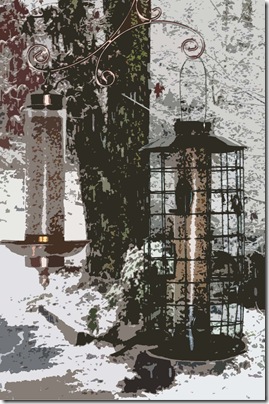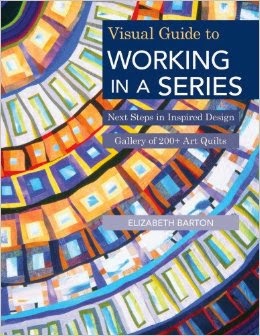I’m off again! This time for a month – and probably beyond the reach of the internet, I’m afraid. but perhaps that will be a good thing! As my internet Scrabble/Lexolous friend says “addicted– 8 letters” – and I am, I am! I’m giving a few phone numbers here in this blog – so that all those shows I’m in can call me and tell me I’ve won a prize!!! (wouldn’t that be nice?) I don’t want to give out phone numbers on my email in case all those people who want to enhance my love life would continue to hound me! If you do need to reach me, please scroll down to the end and you’ll find the numbers, thank you.
My first concern when travelling is always “what will I take to do?”!! My pieces are rarely technique driven, but travelling is one time when a lot of handstitching is a good idea! So I usually have something that requires that technique tickling away at the back of my head….I was playing around on Photoshop with a previous quilt, Rusty Answer, and I realised how much I liked the stitching and how good it would look enlarged, slightly wiggly and quite dense…so that is what I will try!
Tomorrow I fly to the North of England, and I’m going first to the Lake District for a few days. The Lake District is a glorious part of England – natural lakes and mountains abound…Wordsworth lived there and wrote about daffodils, Beatrix Potter wrote about rabbits!  Many painters (notably Turner, Constable and Girtin) have recorded the gorgeous scenery and often the terrible weather!!!
Many painters (notably Turner, Constable and Girtin) have recorded the gorgeous scenery and often the terrible weather!!!
Lake Buttermere (in the Tate collection) Turner.
While recent research (Denis Dutton writes about it in his book The Art Instinct) suggests that most people’s favorite image is that of an open landscape, with water, lots of blue and a few bipeds or quadrupeds, I doubt I’ll be making a quilt that literally portrays the Lakes. One of the aims of the artist should be to show beauty where no one noticed it, rather than to make (what is probably doomed to be) a pallid and predictable copy of amazing natural beauty.
The Lake District boasts the highest mountain in England (Scafell Pike ) which I will view from below, and it’s deepest lake (Wastwater), which I will view from above!
After a 2-3 days in the Lake District, I’m going upto Scotland and will spend a week on the island of Iona. This is a very famous little island because of its long history. The earliest remains are from the Stone Age, then in 600 AD a Benedictine abbey was built – now restored - and the island became a center of Christianity with pilgrims from all over the world. The monks left a strong legacy of arts and crafts in many mediums. Many Scottish kings were buried there too. So there’s all sorts to do and see! And boat trips!!!
I love boat trips and have made several quilts that relate to them. Last year it was a boat trip that started my industrial series.
Rusty Answer
Previously a boat trip out to the Farne Islands led to this piece – one of my all time favorite quilts and the only one I’ve decided not to sell! Yes! you can have all the rest (well, at least so far…)!.
From Iona, I’m going to Knoydart – this is an extremely remote part of Scotland, no roads, just a pub. They say you’re very welcome if you can perform in some way!!Yikes! will I need to learn a monologue? horrors! I’m just hoping to keep my head down for the week I’m there.
The final week I’m away, an old school friend and I will revisit York and we’re actually going to stay in the school we went to – which was a convent founded in the 16th century. The old part of the school is now a bed and breakfast establishment, and there we’ll meet up with another old school friend. Having spent the first half of my life in England, all my oldest friends still live there and it will be wonderful to just take right up again where we left off!
I hope I’ll come back with lots of pictures, inspirations, happy memories and energy! You never know!
So, this is it for a while – as Tony Hancock fans will remember - “I’m going! I’m going!”
Please come back to revisit the blog around the 8th or 9th of June –
and, if you have been, thanks for reading! Elizabeth
Week 1: 011 44 1539 725 894 (this week)
Week 2: 011 44 1681 700 202(next week)
Week 3: 011 44 1687 462 605(week of 24th May)
Week 4: unknown










































